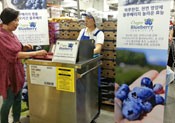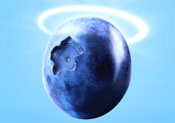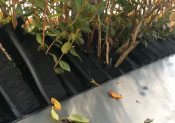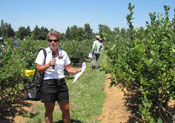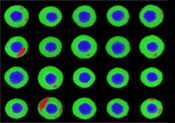Overhead Irrigation Can Reduce Heat Damage
One drawback to an industry shift from overhead to drip irrigation is a higher incidence of heat damage occurring in blueberry production.
In 2015, for example, estimates out of Washington state put heat-damage loss at about $10 million. “Oregon was probably similar,” said David Bryla, a research horticulturalist with the USDA Agricultural Research Service in Corvallis. “We found it in early, mid- and late-season cultivars.”
Bryla initiated a project in 2014 to find ways of reducing problems with heat damage. He unveiled some findings at the 2019 Oregon Blueberry Conference, February 4 in Salem.
 |
| Micro-sprinklers |
In the study, he and his former graduate student, Joy Yang, found that during excessive heat spells they were losing about a pound of fruit per plant to heat damage and they confirmed that use of overhead sprinklers, or micro-sprinklers for cooling, is very effective at reducing that damage. They also found that Aurora was more susceptible to heat damage than Elliott and that green fruit was more susceptible than blue fruit. “We saw damage at cooler temperatures in the green-colored berries than we did in the blue-colored berries,” Bryla said.
In addition, they found that sudden spikes in temperature led to higher damage incidence than when temperatures warmed gradually. The researchers suspect the wax that forms on blueberries during normal development thickens during warm weather and is protecting the fruit from heat damage. However, the wax tends to be thinner when the weather is cooler, which, Bryla said, helps explain why sudden increases in temperature leads to higher damage incidence.
“The bottom line is, we found that once temperatures get to 90 degrees Fahrenheit in the green stage of development, or 95 degrees in the blue stage of development, damage occurs,” Bryla said. “Around 90 to 95 degrees, you should be thinking about turning on cooling systems.”
The researchers found that berry temperatures dropped quickly during cooling, but that there was no need to maintain continuous irrigation to lower the temperatures. Cycling the irrigation was sufficient to keep berry temperatures below damage thresholds.
Running continuous cooling, the researchers found, increased slug pressure and they suspect it may increase susceptibility to fruit rot, although they didn’t measure that.
Running sprinklers an hour on and an hour off was sufficient to reduce berry temperatures during heat spells, Bryla said, as well as running 20 minutes on and 40 minutes off.
“That (20 on and 40 off) works quite well,” he said. “You are putting on enough water to cool the berries effectively, but you are able to reduce the amount of water you use by one-third.”
The researchers found better berry weight, less damage and firmer berries when cooling berries with sprinkler irrigation during heat spells, but slightly lower brix readings, Bryla said.
“Clearly, there is a big effect of cooling on fruit quality, not only on the sizing of the fruit, but on the firmness,” he said.
| SPRING 2019 |

